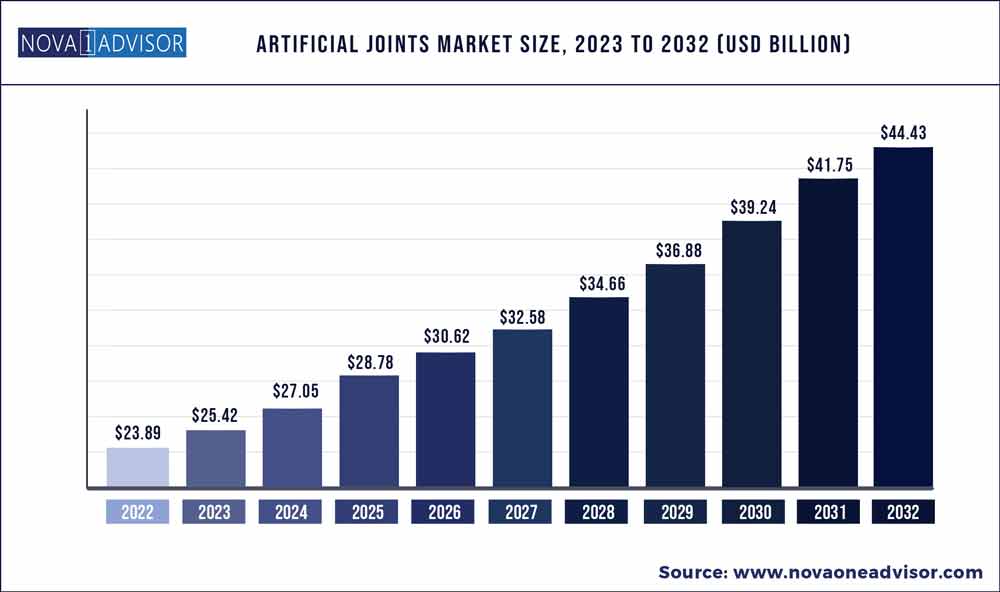The global artificial joints market size was exhibited at USD 23.89 billion in 2022 and is projected to hit around USD 44.43 billion by 2032, growing at a CAGR of 6.4% during the forecast period 2023 to 2032.

Key Pointers:
- North America contributed the largest revenue share in 2022.
- By type, the cemented joints segment is expected to expand at the biggest CAGR between 2023 and 2032 and generated the highest revenue share in 2022.
- By material type, the ceramic segment captured the highest market share in 2022.
- By application, the artificial knee joints segment captured the biggest market share in 2022 and is expected to grow at the highest rate (CAGR) between 2023 and 2032.
- By end users, the hospital segment generated a significant portion.
Artificial Joints Market Report Scope
An artificial joint is a device manufactured from a biocompatible material surgically implanted to replace an existing natural joint. This joint enables improved joint function and corrects abnormalities associated with joint movement. Artificial joints can be designed from ceramic, metal, alloy, or oxinum, and implanted into the site depending on the choice of patient, surgeon, and feasibility of the procedure.
Increase in number of geriatric and obese population and surge in incidence of osteoarthritis and arthritis drive the global artificial joints market. Moreover, technological advancement in artificial joints technology is expected to boost the market growth. However, high cost and complications associated with the artificial joint surgery is likely to hinder the growth of the artificial joints market.
The global artificial joints market is segmented based on material, application, and region. By material, it is classified into ceramics, alloy, oxinium, and others. Based on application, it is categorized into artificial joints of knee, artificial joints of hip, artificial joints of shoulder, and others. Regionally, it is analyzed across North America, Europe, Asia Pacific, and LAMEA. These regions are further analyzed across the country level to determine the market size and forecast for each segment and sub-segment.
An artificial joint is a device manufactured from a biocompatible material surgically implanted to replace an existing natural joint. This joint enables improved joint function and corrects abnormalities associated with joint movement. Artificial joints can be designed from ceramic, metal, alloy, or oxinum, and implanted into the site depending on the choice of patient, surgeon, and feasibility of the procedure.
Increase in number of geriatric and obese population and surge in incidence of osteoarthritis and arthritis drive the global artificial joints market. Moreover, technological advancement in artificial joints technology is expected to boost the market growth. However, high cost and complications associated with the artificial joint surgery is likely to hinder the growth of the artificial joints market.
The global artificial joints market is segmented based on material, application, and region. By material, it is classified into ceramics, alloy, oxinium, and others. Based on application, it is categorized into artificial joints of knee, artificial joints of hip, artificial joints of shoulder, and others. Regionally, it is analyzed across North America, Europe, Asia Pacific, and LAMEA. These regions are further analyzed across the country level to determine the market size and forecast for each segment and sub-segment.
Some of the prominent players in the Artificial Joints Market include:
- MicroPort Scientific Corporation
- Aesculap, Inc.
- Corin Group
- B. Braun Melsungen AG
- Smith+ Nephew
- Medical Devices Business Services, Inc.
- Stryker
- Exactech, Inc.
- Zimmer Biomet
- Medacta International
- Medtronic
- MicroPort Orthopedics Inc.
- Johnson & Johnson Private Limited
- Conformis Inc.
Segments Covered in the Report
This report forecasts revenue growth at global, regional, and country levels and provides an analysis of the latest industry trends in each of the sub-segments from 2018 to 2032. For this study, Nova one advisor, Inc. has segmented the global Artificial Joints market.
By Type
- Cemented Joints
- Non-cemented Joints
By Material Type
- Ceramics
- Alloy
- Oxinium
- Other Material
By Application
- Artificial Knee Joints
- Artificial Hip Joints
- Artificial Joints of the Shoulder
- Other Application
By End User
- Prosthetics Clinics
- Hospitals
- Rehabilitation Center
- Others
By Region
- North America
- Europe
- Asia-Pacific
- Latin America
- Middle East & Africa (MEA)

